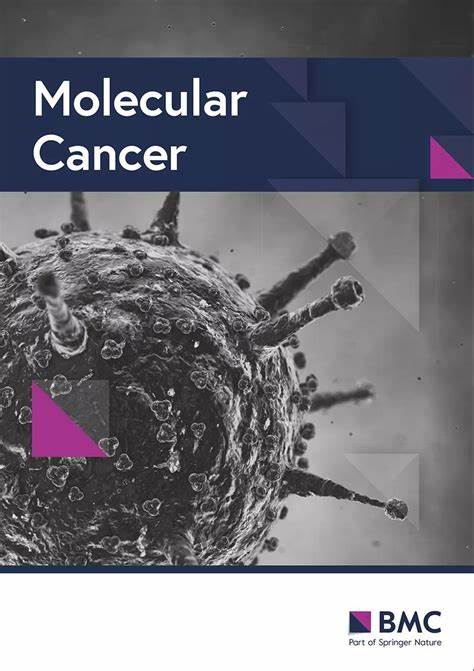微塑料作为新兴致癌物:从环境污染物到致癌驱动因素
IF 33.9
1区 医学
Q1 BIOCHEMISTRY & MOLECULAR BIOLOGY
引用次数: 0
摘要
微塑料(MPs)和纳米塑料(NPs)的广泛环境污染已成为一个重大的公共卫生问题,越来越多的证据表明它们的生物积累与癌症的发生有关。这篇综述对MPs/NPs在癌变中的病因学贡献进行了全面的研究,阐明了它们在体外、体内和患者来源证据中的机制作用。按照PRISMA 2020指南系统地识别和筛选相关研究,以确保方法的透明度和质量。我们强调了最近的发现,强调MPs在几种人类癌症组织中的不同积累,包括肺、结肠、胃、宫颈、乳腺、胰腺、前列腺和阴茎恶性肿瘤。这些颗粒通过慢性炎症、氧化应激、遗传毒性、脂质代谢紊乱和肿瘤免疫微环境的改变诱导有害的生物学效应。值得注意的是,MPs/NPs破坏各种致癌信号通路,特别是NF-κB、PI3K/Akt/mTOR、Wnt/β-catenin和p53,从而促进肿瘤的发生、发展和转移。体外和体内研究证实了MPs/NPs的致癌潜力,说明了它们能够引起细胞转化,增强转移特征,并改变癌细胞的耐药途径。此外,人体生物基质(包括血液、胎盘和肿瘤组织)中MPs的检测强调了人体直接暴露和潜在的全身效应。这篇综述强调了具有治疗意义的机制见解,解决了该领域目前的知识空白。未来的研究必须优先考虑生物标志物鉴定、以患者为中心的调查、治疗靶向以及制定监管政策,以减轻与微塑料暴露相关的健康危害。了解MPs/NPs与癌症生物学之间的复杂关系可以促进与环境污染相关的新型癌症预防和管理策略的发展。本文章由计算机程序翻译,如有差异,请以英文原文为准。
Microplastics as emerging carcinogens: from environmental pollutants to oncogenic drivers
The widespread environmental pollution of microplastics (MPs) and nanoplastics (NPs) has become a major public health issue, with increasing evidence associating their bioaccumulation with cancer onset. This review offers a thorough examination of the etiological contributions of MPs/NPs in carcinogenesis, clarifying their mechanistic roles in in vitro, in vivo, and patient-derived evidences. Relevant studies were systematically identified and screened following the PRISMA 2020 guidelines to ensure methodological transparency and quality. We highlighted recent discoveries that emphasize the varied accumulation of MPs in several human cancer tissues, including lung, colorectal, gastric, cervical, breast, pancreatic, prostate and penile malignancies. These particles induce harmful biological effects by chronic inflammation, oxidative stress, genotoxicity, disturbance of lipid metabolism, and alteration of the tumor immunological microenvironment. Significantly, MPs/NPs disrupt various oncogenic signaling pathways, particularly NF-κB, PI3K/Akt/mTOR, Wnt/β-catenin, and p53, therefore facilitating tumor initiation, development, and metastasis. In vitro and in vivo studies have corroborated the carcinogenic potential of MPs/NPs, illustrating their capacity to cause cellular transformation, augment metastatic characteristics, and modify drug resistance pathways in cancer cells. Furthermore, the detection of MPs in human biological matrices, including blood, placenta, and tumor tissues, highlights direct human exposure and potential systemic effects. This review emphasizes the mechanistic insights with therapeutic significance, addressing current knowledge gaps in the field. Future research must prioritize biomarker identification, patient-centered investigations, therapeutic targeting, and the formulation of regulatory policies to alleviate the health hazards linked to microplastic exposure. Understanding the intricate relationship between MPs/NPs and cancer biology could facilitate the development of novel cancer prevention and management strategies related to environmental contamination.
求助全文
通过发布文献求助,成功后即可免费获取论文全文。
去求助
来源期刊

Molecular Cancer
医学-生化与分子生物学
CiteScore
54.90
自引率
2.70%
发文量
224
审稿时长
2 months
期刊介绍:
Molecular Cancer is a platform that encourages the exchange of ideas and discoveries in the field of cancer research, particularly focusing on the molecular aspects. Our goal is to facilitate discussions and provide insights into various areas of cancer and related biomedical science. We welcome articles from basic, translational, and clinical research that contribute to the advancement of understanding, prevention, diagnosis, and treatment of cancer.
The scope of topics covered in Molecular Cancer is diverse and inclusive. These include, but are not limited to, cell and tumor biology, angiogenesis, utilizing animal models, understanding metastasis, exploring cancer antigens and the immune response, investigating cellular signaling and molecular biology, examining epidemiology, genetic and molecular profiling of cancer, identifying molecular targets, studying cancer stem cells, exploring DNA damage and repair mechanisms, analyzing cell cycle regulation, investigating apoptosis, exploring molecular virology, and evaluating vaccine and antibody-based cancer therapies.
Molecular Cancer serves as an important platform for sharing exciting discoveries in cancer-related research. It offers an unparalleled opportunity to communicate information to both specialists and the general public. The online presence of Molecular Cancer enables immediate publication of accepted articles and facilitates the presentation of large datasets and supplementary information. This ensures that new research is efficiently and rapidly disseminated to the scientific community.
 求助内容:
求助内容: 应助结果提醒方式:
应助结果提醒方式:


